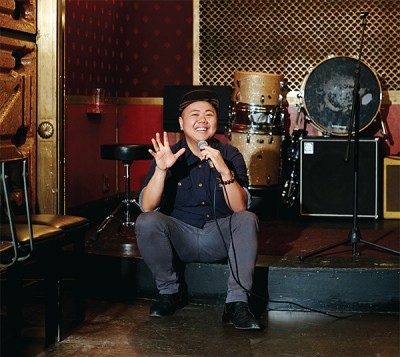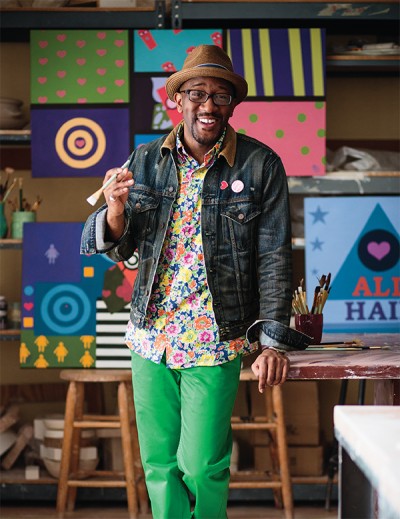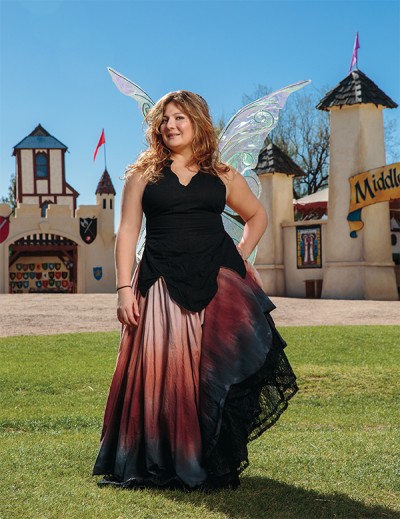
Erica Hession, MSM’10
Driving through the mountains of Arizona, on her way to Texas with a van full of her wares, Erica Hession, MSM’10, suddenly realized she had a problem: her brakes. Miles of steep downhills had overheated them. “They weren’t stopping me at all,” she says.
Pulling over, she contemplated what to do. She could think of no good options. Her cellphone didn’t have service, and the landscape outside her windshield was dry, barren, and full of cactuses. Aside from an occasional tractor-trailer passing by, she was alone. On the road ahead lay more tight curves, with skimpy guardrails on one side and frightening cliffs on the other.
With no better choice, she decided to keep going. Easing the van back on to the interstate, she coasted down the road. “I couldn’t do anything but get out of the mountains,” she says. “I hoped I wouldn’t pick up enough speed to go over the edge.”
Hession’s job, and her life, is the road. As the founder and owner of Aeri Rose, she designs and makes women’s clothing inspired by nature and fairies. She has no office. She doesn’t even have a regular place that she calls home. Instead, the entrepreneur travels most months of the year, selling her clothes at festivals across the country. Hession admits that such a nomadic existence can be wearying. She sometimes daydreams about being settled, about saving in a 401(k) and buying furniture, about not driving so much and having to deal with overheated brakes (a mishap that, fortunately, ended without incident).
But while Hession may not have taken the standard route in her career, she is living life on her terms. Like other bold alumni not afraid to venture off the beaten path, she is unconventional, passionate, and following the beat of her own drummer. “So far, the benefits of a traditional job have not outweighed what I’m doing,” she says. “Starting this business was the best choice I ever made.”

Photo: Winnie Au
Slam poet Kit Yan performs at venues across the country.
The Poet
As the real world beckoned after graduation, Kit Yan ’06 tried working in an office. He had one job in insurance, another in real estate development. He didn’t stay at either for long. “I don’t think I’m suited for a desk job,” says the Brooklyn, N.Y., resident. “I couldn’t stand being in one place for one day. When your heart is somewhere else, it’s hard to concentrate. My heart is with poetry.”
Performing more than 100 times a year at colleges and other venues across the country, Yan works as a slam poet. Poetry obviously is not the most lucrative pursuit, but he has found a way to make it work. “This has been my full-time job for the past eight years,” says Yan, who makes money from selling tickets and merchandise, such as ties, tote bags, and CDs of his poetry. He also teaches poetry and performance in workshops, and he sometimes writes poems and lyrics on commission.
Yan’s love of words can be traced back to his childhood. Growing up in Hawaii, he often heard people use the phrase “talk story.” Hawaiians value the art of storytelling, the simple pleasure of friends hanging out and swapping tales. This suited Yan. “I was kind of a loud-mouthed kid,” he says. “I was always talking.” He also was always writing poems. Friendship was a frequent subject. In his fourth-grade yearbook, he remembers writing poems about memories and the school year.
At Babson, Yan took poetry classes with English professor Mary Pinard. Besides teaching about the fundamentals of poetry, she gave the class an assignment that would change Yan’s life: attend an off-campus poetry reading. Yan stopped by a poetry slam, something he had never seen before. A poetry competition where poets perform rather than read their words, slams are dramatic and intense. “I was absolutely mesmerized by how strong the delivery was,” Yan says. “It was so expressive. It was powerful. It was moving, captivating.”
Soon Yan was performing at poetry slams in Boston and Cambridge. He wasn’t good at first, and the scores he received from slam judges were terrible. “I was nervous,” he says. “I didn’t have a lot of confidence.” Yan kept working at it. On campus, he often was seen walking around and reciting poems out loud. “I was always doing it,” he says. “I was obsessed.”
Yan steadily improved, and he wasn’t afraid to tackle issues in his poems that were very personal. During his time at Babson, Yan wrestled with issues of gender and identity and ultimately began describing himself as a transgender person (individuals whose gender identity differs from the sex they were assigned at birth). “I was trying to figure it out,” he says. “I was always talking about gender, body, sexuality.” These subjects remain a major part of his poems today. Many might feel squeamish talking about such private matters on stage, but Yan feels he has no choice. He’s a poet. He must talk about something. Why not that? “This is just part of who I am,” he says. “It’s something I deal with every day.”
Yan realizes that poems about being a transgender person might not appeal to everyone, and he doesn’t care. “I make art for my audience, my community,” he says. “I do not tailor art to the mainstream. I don’t need to create a work of art that everyone can relate to.” That being said, he knows that many people aren’t familiar with gender identity issues, and he hopes his words might reach some of them. “I have the opportunity to move someone’s heart and change their mind,” he says.
Yan confesses that while he was at Babson, he wondered if it was the right place for him. Perhaps an art school would be more appropriate, he often thought. But now he is grateful for the education he received. It’s essential. When working on his art, he usually thinks of it in business terms. Rehearsal is product development, the audience is his customer, and the stories he tells are his product line. “One of the main reasons I’m able to be a full-time artist is I have a business background,” he says.
The art and business of poetry continue to keep Yan busy. Beyond the constant touring, he’s currently working on new pieces for his stage show, and he has a forthcoming book from Trans-Genre Press. He also is co-creating a musical, Interstate, which has been a long process. Four years have passed, and its debut is still a way off. “It’s gone through a lot of drafts,” Yan says. All this makes for a hectic life, but Yan relishes the creative freedom, artistic integrity, and happiness his career affords him. These rewards are invaluable. “They can’t be measured in money,” he says.

Photo: Pat Piasecki
Painter Jamaal Eversley stands with some of his work.
The Painter
Picking Jamaal Eversley ’10 out of a group of people isn’t difficult. Find the sharp dresser with the bold colors, the man looking showy yet classy, a mix of Prince and Sinatra. “Colors bring everything to life,” Eversley says. But while his wardrobe grabs attention, he insists that’s not his intention. “This is who I am. It’s not, ‘look at me.’ It’s, ‘this is me,’” says the Randolph, Mass., resident. “It’s not about standing out. It’s about being comfortable. You’re not in the back. You’re in the forefront.”
Eversley is a painter. It’s not the easiest choice for a career. To earn some extra spending money, he works a part-time job or two, including manning the perfume counter at Nordstrom’s. He also lives with his mom. Eversley is well aware of the more typical path that people take with their lives—they go to college, get a nice job, and then settle down with a spouse, kids, and a house. But that well-worn road isn’t for him. “I’m trying a road that is less traveled,” he says. “I’m trying to do what’s in my heart.”
Art has been part of Eversley’s life for a long time. He enjoyed drawing with the colored pencils his mom gave him in the fourth grade, and he took art classes in high school. He found painting and drawing to be a peaceful, meditative process. When he came to Babson, though, he intended to put art aside. “At the time, I wanted to go to Wall Street and make lots of money and be in nice suits,” he says.
Then as a first-year, he was walking outside and came upon a drawing class taught by artist-in-residence Danielle Krcmar. He stopped. The class wasn’t what he expected at a business school. “What the hell?” he asked her. “There’s art here?” Eversley became fast friends with Krcmar and soon was attending all the exhibits and events he could find on campus: plays, poetry readings, dance performances. “I went to all of that,” he says. “All forms of art spoke to me.” Eventually he began painting again, and he had a big exhibit on campus his senior year. Not many in his life knew that he was such a serious artist. His mother came to the exhibit opening and was stunned. “When she saw the work I had there, she was thinking there’s more to this guy than I thought I knew,” Eversley says.
When he graduated, Eversley wanted to live a life centered around art in some way. At first, he focused more on acting than painting. He attended the Stella Adler Studio of Acting in New York and acted in community theater productions and student films. He also appeared as an extra in big-screen movies, including Ted and American Hustle. But Eversley came to a realization. Acting is like trying out for a sports team, he says. If you’re picked for a part, that’s great. If you’re not picked, you’re stuck on the sidelines. “You’re a boy with a football and no one to throw it to,” he says.
Deciding to make painting his priority once again, Eversley found some recognition with his work exhibiting at galleries, colleges, and libraries. But one big obstacle still loomed if he wanted to be a successful, full-time artist: debt. To pay off his car and student loans, he took a full-time job in 2014 and also added a couple of part-time gigs. All the working, though, made him tired. He struggled in his free time to find the energy to paint. “Why am I doing this?” he asked himself. “I want to be creating. I want to be inspiring people. I feel like I’m dying, not doing what I’m supposed to do.”
So Eversley quit the full-time job. He now has more time to paint, of course, but also to apply for grants and residences and to think about his brand. Many artists don’t think of themselves as having a brand, says Eversley, but that’s because they didn’t have the advantage of a business school education. “Babson made me realize it’s all business,” Eversley says. “Your career is about your art. But it’s also about building a brand around it.” One of his artistic heroes is Andy Warhol. Eversley admires not only the originality of the pop artist’s work but also his marketing. Think of Andy Warhol, he says, and you think of both his art and his persona. Warhol’s look and his life are as much a part of the painter’s brand as his distinctive paintings. “He was a marketing expert,” Eversley says.
To help create a brand for himself, Eversley currently is working on a series of paintings united by a similar feel. The series, called Love Ballads, features simple yet striking imagery: hearts, polka dots, arrows, stripes, and a character that he calls the Nerd. And much in the way that Eversley dresses, the paintings will be loaded with bright colors. He thinks that such a fun, flashy look is in fashion now. “This is the time. Look at sneakers. Look at the colors of pants,” says Eversley, who hopes the works will have a wide appeal. “I want art that is universal, that can touch everyone somehow.”

Photo: Chris Hinkle
A designer of clothes inspired by nature and fairies, Erica Hession, MSM’10, sells her wares at Renaissance fairs and other festivals.
The Designer
Throughout much of the year, clothing designer Erica Hession lives a gypsy life, hopping from festival to festival across the country. She began the year with an eight-week stop in Arizona, followed by another eight-week stop in Texas. Treks to Virginia, Pennsylvania, New York, and Maryland come next. During the busy festival days, she interacts with customers and sells her Aeri Rose clothes, while at night she winds down with fellow vendors. “We sit around a campfire swapping stories, playing music, and enjoying each other’s company,” she says.
Hession sells clothes at a variety of events, including art, music, and Irish festivals, but her main business is at Renaissance fairs, fanciful happenings that conjure up the times of lords, ladies, and knights. Dressing up in costume, eating turkey legs, and watching jousts are all standard Renaissance fair activities. So is shopping. “On the surface, it may seem silly. You’ll see a castle wall, and people are trying to talk with bad accents,” Hession says. “But to me, if you look past the silliness, you see the festivals as a place full of entrepreneurs and artists. There is a community of traveling artists who are making a living doing this.”
Hession makes and sells skirts, dresses, and summery tops. Flowing and colorful, they look like clothes that fairies might wear for a frolic through the forest. “I’m selling fun and whimsy and a carefree time to customers,” Hession says. Buying such clothes is a different shopping experience from what many women are used to; this isn’t a department store. “I feel when women go shopping, it’s this weird, bittersweet thing, because while they like buying new clothes, they don’t like trying them on—the clothes are made for models,” Hession says. Dress like a fairy, however, and that self-consciousness frequently melts away. “They allow themselves a lot more liberty in choosing colors and cuts and styles,” she says. Hession often dresses as a fairy at the festivals, though she’s also practical. One can’t don a tutu and wings all the time. “You can’t go to the grocery store dressed like that,” she says. “Maybe you can if you’re 5.”
Hession first kicked around the idea of selling clothes as an undergraduate business student at Drexel University. She and her roommate were interested in the green movement and wanted to start a company that would repurpose old clothing into new styles. “That idea didn’t really get far out of the living room,” she says. After receiving her master’s degree in global entrepreneurship from Babson, though, Hession was eager to give the entrepreneurial life a whirl. “Being surrounded by entrepreneurial types whose favorite question is ‘what if’ is really exciting and inspiring,” she says. Hession dusted off the idea of starting a clothing company, and Renaissance fairs seemed like a good market to tap. Growing up in Maryland, Hession worked at the state’s Renaissance fair in high school and college, so she knew about the community of vendors who traveled with the festivals. As someone with a strong case of wanderlust, she saw their lives as an intriguing way to live.
Hession launched her business in 2011. At first, it grew slowly, though that didn’t bother her. Not sure if the venture was something she wanted to pursue for the long haul, she was content seeing the country and meeting interesting people. “I was floating around,” she says. “That was enough.” In time, though, Aeri Rose grew, as did Hession’s commitment and ambition. Today, business is strong enough that she sometimes sets up a team to sell her wares at fairs she can’t attend herself. She also has added necklaces to her product line, written a children’s book, The Gift of the White Elephant, with an accompanying audio book, and even put together a runway collection that was inspired by circuses for Baltimore Fashion Week last year.
All this success, however, has created a problem. By herself, Hession makes all the clothes that she sells, but her busy travel schedule only leaves so much time for production. “My inventory constraints are limiting my growth,” she says. “I want to get away from making everything myself.” She has thought about taking production overseas, though she would like to continue manufacturing in America. She fantasizes about owning a townhouse in a city like Philadelphia. The basement could be her workshop, and she could hire a seamstress. The first floor could be her storefront, while the top floors could be her living space. After so many miles on the road, a home base to run her business and settle down a bit sounds appealing. “It would be nice to find a place where I can put something down, and it’ll be there when I get back,” she says.
Not that she’s ready to give up traveling completely. Hession describes her life and career as the “scenic route.” She still relishes seeing places and meeting people, particularly her customers. “I feel like I would miss that, if I was locked away in an office with no direct contact with the customers that keep the business alive,” she says. “I am grateful to each and every supporter.”
